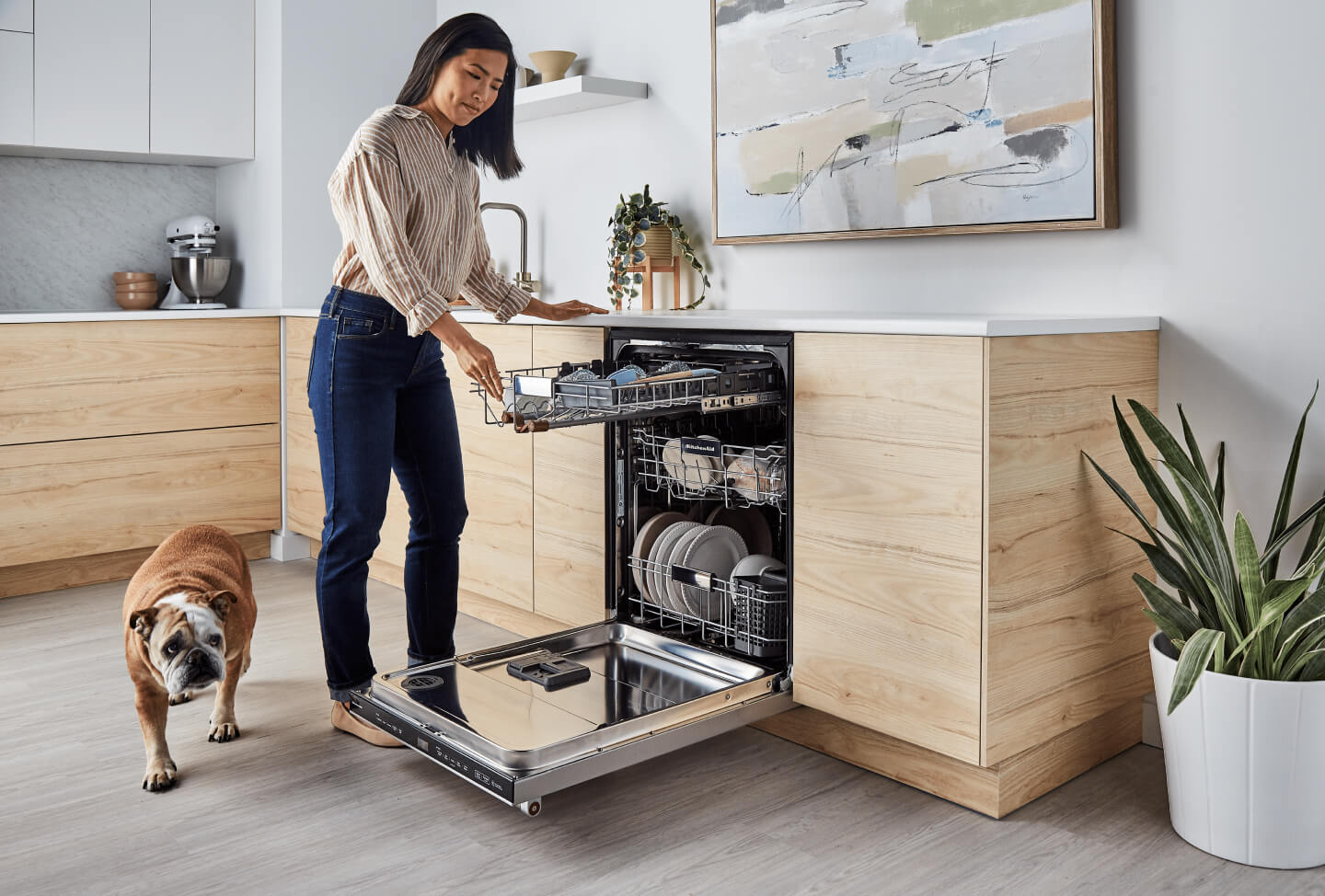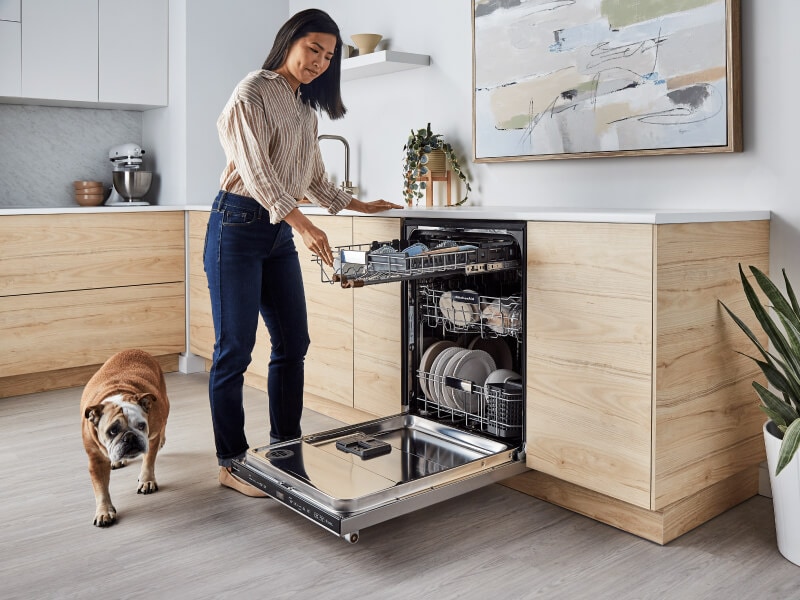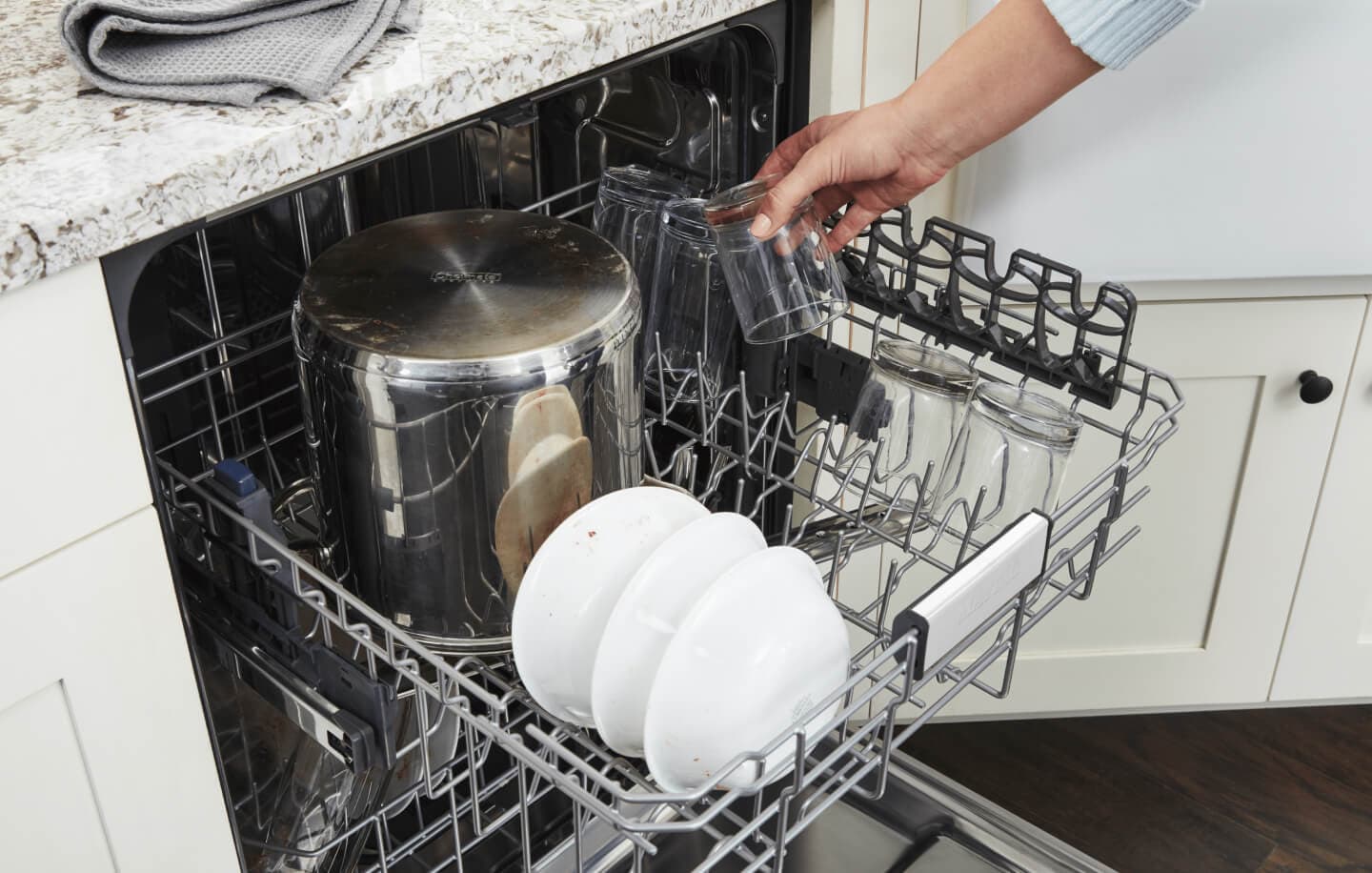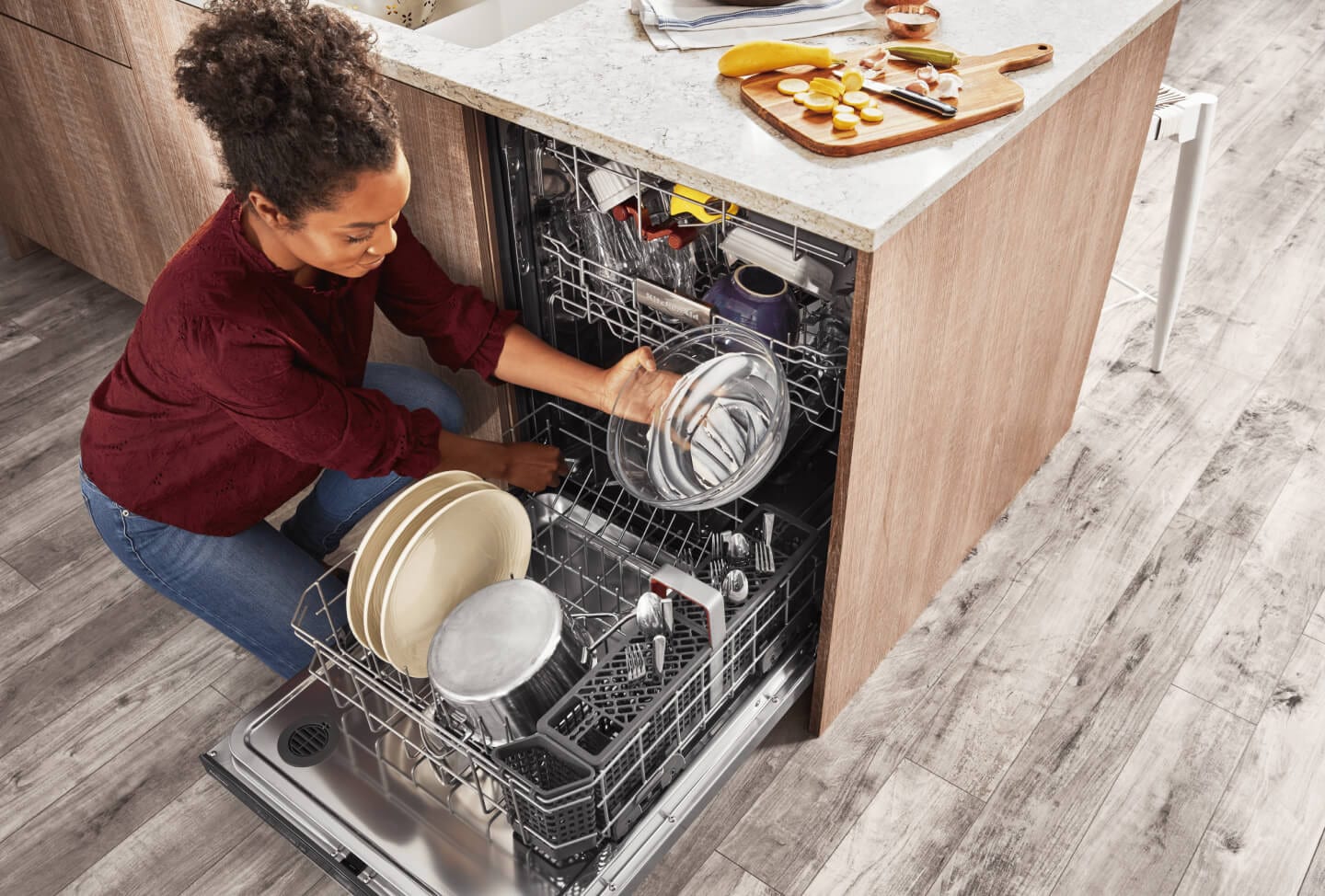
How to properly load a dishwasher for best results
For dishes that sparkle after each wash cycle, you’ll want to know the proper placement for each item in your dishwasher. Use this guide to learn a few tips on how to properly load a two-rack or three-rack dishwasher to help get your dishes and cookware clean and ready for your next creation.


Is there a correct way to load a dishwasher?
For optimal results, load smaller items like mugs, stemware and small plates or bowls in the top rack of your dishwasher. Load larger items like dinner plates, cookware and pans in the bottom rack. Placing items facing downward, toward the center of your racks makes it easier for spray arms to reach food residue, and helps dishes come out clean.
Dishwasher loading tips
Before you begin, review these tips for loading a dishwasher properly.
Remove any food, bones, toothpicks and other hard items from your dishes.
Remove labels from jars or containers.
Load from back to front on both the upper and lower rack. Unload from bottom to top so any water pooled on upper rack dishes doesn’t drip on dry lower rack dishes.
Place items facing the center of the dishwasher and angled down toward the spray jets. Placing them at an angle will not only help with cleaning but will also help ensure proper draining and drying. If your dishes aren’t drying in the dishwasher, it may be because of improper dish placement.
Diagram of ideal dishwasher loads
The proper way to load your dishwasher depends on whether you have a third rack or two rack model. KitchenAid® Dishwashers with a Third Rack let you free up more space in top and bottom racks with a convenient third rack that can fit items like silverware, measuring cups and spatulas.


1. For more information on loading the KitchenAid® 360º Max Jets™ Third Rack Dishwasher, see your Use and Care Guide.
How to load a dishwasher
To load your dishwasher, start by scraping off excess food and waste from your dishes, and removing container labels where necessary. Then, load items angled downward, toward the center of the rack from top to bottom. This helps ensure the spray jets can reach the surface of your dishes to help them come out clean.


1. Load the upper rack
Place items like mugs, stemware, plasticware or small plates in the top rack, using the machine’s tines to secure items as needed. Angle items downward so they don’t overlap and are unable to fall through the rack openings.
What goes on the top rack of a dishwasher?
Place mugs, cups, drinking glasses and stemware face down along the sides of the upper rack. Position these items between the tines—not on them—to keep them more secure. Some dishwashers come with stemware holders to help protect wine glasses and champagne flutes. KitchenAid brand offers dishwashers with two, four and six stemware holders to help keep your favorite glasses safe.
Small bowls and plates should be placed between the tines and angled downward toward the center of the dishwasher. Be sure to avoid “nesting” or overlapping bowls to help ensure optimal cleaning.
Large utensils, spatulas and ladles should be laid flat on the upper rack. Avoid placing these items in the utensil holder, as they can potentially block a lower level spray arm. Smaller utensils can also be loaded on the upper rack as well; just make sure they’re placed so they won’t fall through an open space in the rack.
Plastic containers should be loaded on the upper rack, away from the heating element to help avoid warping or melting. And only wash plastic items that are marked “dishwasher safe.”


2. Load the lower rack
Load the bottom rack with larger items, like bowls, dinner plates and dishwasher-safe cookware, making sure to alternate large and small items so the spray arms can reach the surface. When loading large items like cutting boards or pans, ensure the spray arm isn’t impeded. If items are too large, they may need to be laid down on their sides or placed around the dishwasher’s perimeter.
What can go on the bottom rack of a dishwasher?
- Load larger items like plates, large bowls, dishwasher-safe casserole dishes and stainless steel cookware in the bottom rack of the dishwasher.
Place soiled pans, bowls and casserole dishes on their sides. This is especially important for older dishwashers that might only have a spray arm in the bottom of the tub that could potentially get blocked by a face-down dish.
Make sure plates are placed between the tines and there is room between plates. If possible, alternate large and small plates to improve surface area exposure. The soiled surfaces of plates should be angled toward the jets at the bottom of the dishwasher.
When loading pots and pans make sure handles are pointing away from spray arms so cleaning isn’t impeded.
Platters and dishwasher-safe cutting boards should be placed along the perimeters of the lower rack. Make sure they don’t block spray arms and avoid placing them in the front of the rack, as this could prevent detergent from dispersing properly.


3. Load the Utensil Holder
With the exception of knives, cutlery should be loaded in the utensil holder with handles down. If your utensil basket doesn’t have covers, alternate the handle placement of forks and spoons to avoid nesting, which can keep water and detergent from hitting all surfaces. Place knives and skewers with blades down to help protect your fingers from getting nicked or cut when emptying the dishwasher.
How to Load Dishwashers With Third Racks
Depending on what your third rack can fit, place items face down on the rack, making sure to leave enough space between each dish or utensil to allow soap and water to flow through.
KitchenAid brand offers Third Level Utensil Rack Dishwashers designed to hold large, flat items like spatulas and serving utensils to free up space in the lower racks. The KitchenAid® 360º Max Jets™ Third Rack Dishwasher is the largest third rack dishwasher available2 and provides versatile loading options. A deep, angled design fits 6" glasses, mugs and bowls. Rotating jets target the Third-Level Rack while a drying bar wicks away moisture.
2. Among leading brands based on usable volume.
How not to load a dishwasher: 3 common mistakes to avoid
When loading your dishwasher, be careful to avoid common mistakes, such as overloading your dishwasher by stacking or nesting items. Be sure to wash only items marked dishwasher-safe and—other than scraping your dishes free of larger food items—skip pre-rinsing your dishes (your appliance and detergent are designed to do this for you!)
1. Pre-rinsing dishes
A dishwasher’s job is to wash the dishes, so you don’t have to, but many people still get carried away with pre-rinsing. If you’ve bought a dishwasher within the past 10 years, there’s no need to do this. Not only is over-zealous pre-rinsing a waste of time and resources, it can actually interfere with the cleaning process. Most modern dishwashers have built-in sensors that measure the soil-level of your load. If your dishes don’t have any soil on them, the dishwasher might be cutting your cycle short, leaving your dishes less than sparkling.
2. Overloading your dishwasher
Everyone is concerned about the planet these days but keep in mind that overloading your dishwasher may not be helping in the way you want it to. Dishes need a little space—if water can’t reach them, they won’t get clean. So, by all means, avoid stacking and nesting dishes to help prevent washing them a second time or overflowing the dishwasher.
If you have a large household or do a lot of cooking or entertaining and are consistently running larger loads, the KitchenAid® 360º Max Jets™ Third Rack Dishwasher is designed to take on large loads.
3. Loading non-dishwasher safe items
Before you put anything in your dishwasher, make sure it’s dishwasher safe. Here are some items that need hand washing:
Wooden cutting boards, bowls and utensils: They’re porous and might warp.
Cast iron and non-stick pans: Hot water and detergent can destroy their coatings.
Silver or enamel: Heat and detergent can ruin these finishes.
- Fine china: Some dishwashers have cycles specifically designed for fine china, but keep in mind that these items can break or chip easily.
Unloading the dishwasher: Is there a wrong way?
There is no wrong way to unload a dishwasher, but you can help make the task easier by unloading heavier items first and sorting dishes and utensils as you unload. This can help you stay organized and efficient, making kitchen clean-up less of a chore.
Dishwasher unloading tip:
Many dishwashers come with a clean indicator light that will illuminate to signal that dishwashing is complete. The light will often remain illuminated until the dishwasher is opened to eliminate the question of whether the load of dishes is clean or dirty.
Explore dishwashers from KitchenAid®
KitchenAid® dishwashers are designed with thoughtful features that make loading the dishwasher simple and intuitive after a day filled with making. Select features like the 360º Max Jets™ Third Rack offer the adjustable space you need, so you can focus more on what you create rather than what you have to clean. With dishwasher models that come in stainless steel, black stainless steel, panel-ready and more, there’s a variety of design styles to choose from.

